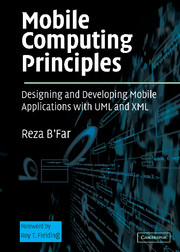Book contents
- Frontmatter
- Contents
- Foreword by Roy T. Fielding
- Acknowledgments
- SECTION 1 INTRODUCTIONS TO THE MAIN TOPICS
- SECTION 2 DEVICE-INDEPENDENT AND MULTICHANNEL USER INTERFACE DEVELOPMENT USING UML
- Chapter 5 Generic User Interface Development
- Chapter 6 Developing Mobile GUIs
- Chapter 7 VUIs and Mobile Applications
- Chapter 8 Multichannel and Multimodal User Interfaces
- SECTION 3 ADDITIONAL DIMENSIONS OF MOBILE APPLICATION DEVELOPMENT
- SECTION 4 PUTTING THE PROJECT TOGETHER
- References
- Index
Chapter 8 - Multichannel and Multimodal User Interfaces
from SECTION 2 - DEVICE-INDEPENDENT AND MULTICHANNEL USER INTERFACE DEVELOPMENT USING UML
Published online by Cambridge University Press: 03 September 2009
- Frontmatter
- Contents
- Foreword by Roy T. Fielding
- Acknowledgments
- SECTION 1 INTRODUCTIONS TO THE MAIN TOPICS
- SECTION 2 DEVICE-INDEPENDENT AND MULTICHANNEL USER INTERFACE DEVELOPMENT USING UML
- Chapter 5 Generic User Interface Development
- Chapter 6 Developing Mobile GUIs
- Chapter 7 VUIs and Mobile Applications
- Chapter 8 Multichannel and Multimodal User Interfaces
- SECTION 3 ADDITIONAL DIMENSIONS OF MOBILE APPLICATION DEVELOPMENT
- SECTION 4 PUTTING THE PROJECT TOGETHER
- References
- Index
Summary
Seek first God's Kingdom, that is, become like the lilies and the birds, become perfectly silent. Then shall the rest be added to you.
Søren KierkegaardINTRODUCTION
We have thus far discussed user interfaces in some detail. We have seen that, depending on the function of the mobile application, we may want to interact with the user through audio, a traditional GUI, or a combination thereof. We have also seen that, because of the wide variety of capabilities among mobile devices and the proliferation of the platforms, there are a great number of user interfaces that we may have to implement for a given application. Although we have looked at mobile GUIs and then VUIs individually, we have not looked at the discipline of building applications that may use more than one channel of communication with the network or interact with the user through more than one mode of their user interface. This is what we will be discussing in this chapter.
First, let us define what multichannel and multimodal mean for these two terms have been incorrectly used widely in the literature on mobile computing. To start, remember that multimodal and multichannel are not the same thing. Multichannel may have two different meetings. First, it can be used to imply a user interface that establishes more than one communication channel to the user. For example, a user interface may present an audio and a video channel to the user.
- Type
- Chapter
- Information
- Mobile Computing PrinciplesDesigning and Developing Mobile Applications with UML and XML, pp. 497 - 554Publisher: Cambridge University PressPrint publication year: 2004



